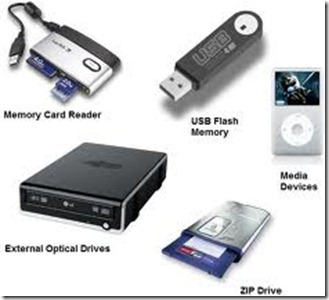STORAGE DEVICES AND MEDIA
A store is a part of a computer system where data and instructions can be held, ready for later
Examples of stores
1 The main store of a computer.
2 A floppy disc.
To write data into store means to transfer it from the central processing unit to the storage medium.
To read data from the store means to transfer it from the store to the central processing unit.
A volatile store is one which loses its data when the power is switched off. The RAM in computers is usually volatile (see below), although some microcomputers have RAM which is maintained by batteries.
A nonvolatile or permanent store is one which does not lose its data when the power is switched off.
To save a program means to have it read from the computer’s main store and written to a permanent store.
To load a program means to have it read from a permanent store into the computer’s main store.
Note: People also refer to saving and loading data-particularly in word processing.
Examples of saving and loading
1 A programmer may ‘load a program, correct it and then save the new version.
2 The user of a particular program has to load it from disc before running it.
To access data means to get ready to transfer data and then to transfer it. The term is often used to refer to reading data but can be used for writing as well.
The access time for a particular device is the time taken to locate data and to transfer it ready for use.
Example of access time
If data is read from a magnetic disc the access time is in three parts:
1 The seek time-the time to move the read/write heads across the disc to the right track.
2 The rotational delay-the time for the disc to rotate to the right place for reading.
3 The transfer time-the time taken actually to read the data.
Note: For details of how data is stored on discs .
LEVELS OF STORAGE
Store is classed into levels depending on how quickly the computer can access it. A store which can be accessed quickly is at a higher level than one which cannot.
The two main levels of storage are:
1 Main store (or main memory or immediate access store)
(a) It is divided into locations. The computer can access any of the locations directly using a number called its address. Each location has a different address.
(b) Access to it is very fast. Reading and writing are done electronically without any mechanical movement.
(c) The main store contains the working store of the computer. This consists of RAM (random access memory). While a program is running, the program itself is usually stored here. So are any variables used by the program. This part of the store is usually volatile.
(d) The main store also usually contains some ROM (read only memory). This contains certain programs which are stored permanently.
2 Backing store (or auxiliary store or secondary storage)
(a) This is storage outside the central processing unit.
(b) It usually needs mechanical read/write heads to access it.
(c) Access to it is slower than the main store.
(d) It is nonvolatile so that it can be used to store data permanently.
Usually backing storage devices are on-line to the computer. However, backing storage media such as magnetic tapes and discs may be stored off-line.
Examples of on-line and off-line storage
1 A network in a school has a hard disc unit always on-line. However, pupils may decide to buy their own floppy discs and keep their programs off-line.
2 A large computer installation keeps all regularly used files on discs which are permanently on-line. However, users may store seldom-used files in a magnetic tape library in the computer room. If a program needs one of these tapes a monitor in the computer room will show a request for it. The computer will suspend running of this program until an operator has found the tape in the library and has loaded it on to a tape unit.
REASONS FOR DIFFERENT LEVELS OF STORAGE
1 Working store is necessary:
(a) For storage of the program currently being executed.
(b) to hold data produced as the program is run.
(c) To hold data needed by the instruction being executed.
For each of these it is necessary to have a store which can be accessed very quickly. It may not matter if the store is volatile if the program and data are only in the store while the program is running.
2 Backing store is necessary:
(a) For data and programs which are to be stored for a long time. The computer may be used for other programs or may be switched off, but data on backing store will still be there.
(b) For data and programs when there is not enough room in the main store.
3 Off-line backing store is necessary:
(a) When not all the programs and data needed for a computer system can be kept on-line at once. On-line backing store is expensive and there may not be enough of it.
(b) So that programs and data can be taken away and used on other computers.
(c) When the stored data is used to operate other equipment, such as plotters.
(d) For security-important programs and data can be kept in a separate building in case of fire or theft.

